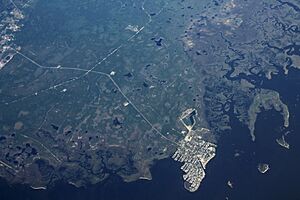Horseshoe Beach, Florida facts for kids
Quick facts for kids
Horseshoe Beach, Florida
|
|
|---|---|

Aerial photo of Horseshoe Beach
|
|

Location in Dixie County and the state of Florida
|
|
| Country | |
| State | |
| County | Dixie |
| Settled (Butler Settlement) |
c. 1820s-1890s |
| Settled (Shelton) | 1910 |
| Settled (Horseshoe) | 1935-1948 |
| Incorporated (Town of Horseshoe Beach) | May 28, 1963 |
| Government | |
| • Type | Mayor-Council |
| Area | |
| • Total | 0.52 sq mi (1.34 km2) |
| • Land | 0.47 sq mi (1.21 km2) |
| • Water | 0.05 sq mi (0.12 km2) |
| Elevation | 7 ft (2 m) |
| Population
(2020)
|
|
| • Total | 165 |
| • Density | 351.81/sq mi (135.89/km2) |
| Time zone | UTC-5 (Eastern (EST)) |
| • Summer (DST) | UTC-4 (EDT) |
| ZIP code |
32648
|
| Area code(s) | 352 |
| FIPS code | 12-32650 |
| GNIS feature ID | 0284297 |
Horseshoe Beach is a small town in southern Dixie County, Florida, United States. It is located along the Gulf of Mexico, which is a large body of water connected to the Atlantic Ocean. The town is part of the Big Bend and Nature Coast areas in North Florida. In 2020, about 165 people lived there.
Contents
Exploring Horseshoe Beach's Location
Horseshoe Beach is found in the southern part of Dixie County. Its exact spot is at 29.440547 degrees North and 83.288776 degrees West. This small town sits right on the Gulf of Mexico.
The only main road leading into Horseshoe Beach is County Road 351. This road goes about 19 miles (31 km) northeast to Cross City. Cross City is the main town in Dixie County.
According to the United States Census Bureau, Horseshoe Beach covers a total area of about 0.52 square miles (1.34 square kilometers). Most of this area, about 0.47 square miles (1.21 square kilometers), is land. The rest, about 0.05 square miles (0.12 square kilometers), is water.
Understanding Horseshoe Beach's Climate
The weather in Horseshoe Beach is known for its hot and humid summers. Winters are usually mild, meaning they are not too cold. This type of weather is called a humid subtropical climate. It means the area gets a lot of rain and has warm temperatures for most of the year.
Population Changes in Horseshoe Beach
A census is like a big count of all the people living in a place. It helps us understand how many people live in a town and what groups they belong to.
| Historical population | |||
|---|---|---|---|
| Census | Pop. | %± | |
| 1970 | 124 | — | |
| 1980 | 304 | 145.2% | |
| 1990 | 252 | −17.1% | |
| 2000 | 206 | −18.3% | |
| 2010 | 169 | −18.0% | |
| 2020 | 165 | −2.4% | |
| U.S. Decennial Census | |||
Population Details from 2010 and 2020
The 2020 United States census showed that 165 people lived in Horseshoe Beach. There were 49 households and 30 families.
The 2010 United States census counted 169 people, 57 households, and 44 families in the town.
The table below shows the different groups of people living in Horseshoe Beach based on the 2010 and 2020 censuses. It helps us see how the town's population has changed over time.
| Race | Pop 2010 | Pop 2020 | % 2010 | % 2020 |
|---|---|---|---|---|
| White (NH) | 167 | 144 | 98.82% | 87.27% |
| Black or African American (NH) | 0 | 1 | 0.00% | 0.61% |
| Native American or Alaska Native (NH) | 0 | 1 | 0.00% | 0.61% |
| Asian (NH) | 0 | 2 | 0.00% | 1.21% |
| Pacific Islander or Native Hawaiian (NH) | 0 | 0 | 0.00% | 0.00% |
| Some other race (NH) | 0 | 0 | 0.00% | 0.00% |
| Two or more races/Multiracial (NH) | 0 | 6 | 0.00% | 3.64% |
| Hispanic or Latino (any race) | 2 | 11 | 1.18% | 6.67% |
| Total | 169 | 165 |
See also
 In Spanish: Horseshoe Beach para niños
In Spanish: Horseshoe Beach para niños

